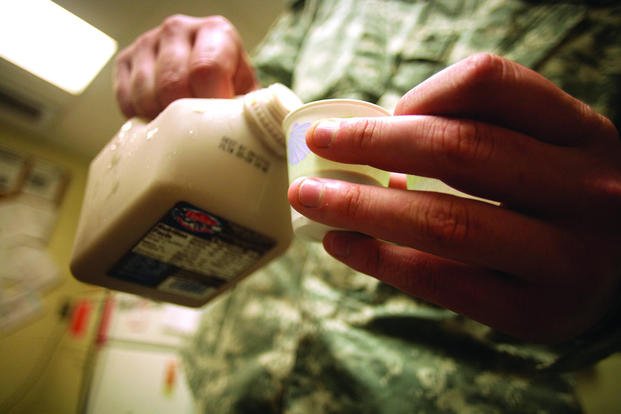Most of the time, Wednesdays are used to answer questions for the Ask Stew column, but after several questions and comments about drinking chocolate milk and other dairy products for post-workout and recovery drinks, we ask the folks at the National Dairy Council. The answers include links to scientific research and studies on the topic, as well as information on the positive reasons for a moderate milk intake. Most Americans do not drink enough, according to the U.S. Department of Agriculture.
- Is chocolate milk a good post-workout drink?
- Depending whether your goal is to lose or gain weight, is chocolate milk a good go-to drink?
- The sugar content of chocolate milk is not for everyone, but is it fine for the growing 18- to 22-year-old seeking military service?
- Who should not drink chocolate milk as a post-exercise drink?
Whether white or chocolate, milk provides many key nutrients that can help support recovery and maximize performance after a workout. Scientific research has identified low-fat chocolate milk as an effective workout recovery drink. Sports nutrition experts recommend adequate fluids, electrolytes, energy, carbohydrates and protein for optimal post-workout nutrition.

Milk is a wholesome food that can help refuel muscles with carbohydrates, rebuild and repair muscles with high-quality protein, and rehydrate and replace what was lost in sweat with fluid and electrolytes. Studies have shown that drinking chocolate milk after a workout may help reduce muscle damage and improve recovery, which may help the body perform better during its next workout.
There are a lot of options when it comes to post-workout nutrition, and milk, including chocolate milk, is a delicious, easy and cost-effective way to provide a unique combination of nutrients, fluid and electrolytes to help support post-exercise recovery.
Research shows that drinking milk after a workout can be as effective as, if not, more effective than, some sports drinks in helping the body refuel, recover and rehydrate from exercise. A study from 2011 found those who drank chocolate milk, versus a carbohydrate-only beverage after exercise, had better improvements in aerobic fitness and body composition at the end of a 4.5-week cycling training program.
Whey protein, a high-quality protein naturally found in dairy, is also a convenient and versatile post-workout option that is high in the essential amino acid leucine, which can help build and repair muscles.
Chocolate milk in moderation can fit into any healthy eating plan. Just like white milk, chocolate milk provides nine essential nutrients important for overall health while contributing only 4% of added sugars children and adolescents consume daily. Milk can increase the body's ability to make new muscle and may help improve body composition over time, when it's enjoyed as a post-workout beverage.
At the end of the day, it's important to remember that everyone should create a tailored plan that suits their health and wellness needs. The timing and composition of the post-competition or post-exercise meal or snack depends on the length and intensity of the exercise session and when the next intense workout will occur.

- Many of my readers are interested in any other facts/myths about the nutritional impact of dairy, comparing dishes with/without dairy products. What are the nutritional disparities between adding or omitting dairy from some typical foods in our diet?
Milk, cheese or yogurt can add more nutrition and great taste to foods with which you pair them, including whole grains, pasta, burgers, tacos, fruits, veggies, etc. "An eating pattern is more than a sum of its parts," states the 2015 Dietary Guidelines for Americans. It's about choosing a variety of nutrient-rich foods, which includes low-fat and fat-free dairy foods, from all food groups that work together to support health.
With the abundance of information out there, it can be difficult to know what to believe when it comes to the food we eat. There are many ways to build a healthy eating plan; however, dairy products, such as milk, cheese and yogurt, play an essential role because of their unique set of nutrients and health benefits as part of healthy eating styles. Plus, they're delicious, there's a variety of options to choose from and they come at a reasonable price.
Milk is the number one food source of calcium, vitamin D and potassium -- all nutrients of concern -- in the diets of children and adults. Dairy foods (and dairy nutrients) are under-consumed by Americans, and milk's nine essential nutrients can be difficult to replace in a healthy eating pattern.
It can be challenging for Americans age 9 and older to meet nutrient recommendations without eating three servings of dairy foods a day. Replacing dairy foods with other food sources of calcium within a healthy dietary pattern would require a significant change in the eating habits of most Americans. In fact, it would require more than one serving of a fortified soy beverage or bony fish, or more than two servings of leafy greens, to meet the calcium in one cup of milk.
The above responses are from Greg Miller, chief science officer of the National Dairy Council.
Do Some Research
Those who have issues digesting dairy or are sensitive to sugar may want to limit their intake of carbohydrates (diabetic). It is estimated that 30 to 50 million Americans are lactose intolerant, and more than 30 million are diabetic, so milk is not for everyone. However, lactose-free is an option for those who are intolerant, but it is sweeter than regular milk and has a higher glycemic index.
There are many dietary professionals who will argue milk is not needed or to avoid it all together. There is no argument that dairy is highly nutritious and finding comparable foods and drinks with that nutritional value is possible but difficult. The key is to find what works best for you. Test out dairy by itself or mixed with foods and see how you handle it with your dietary and fitness goals.
Stew
Stew Smith is a former Navy SEAL and fitness author certified as a Strength and Conditioning Specialist (CSCS) with the National Strength and Conditioning Association. Visit his Fitness eBook store if you're looking to start a workout program to create a healthy lifestyle. Send your fitness questions to stew@stewsmith.com.
Want to Learn More About Military Life?
Whether you're thinking of joining the military, looking for fitness and basic training tips, or keeping up with military life and benefits, Military.com has you covered. Subscribe to Military.com to have military news, updates and resources delivered directly to your inbox.




















